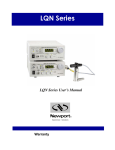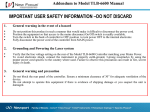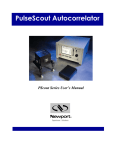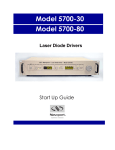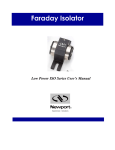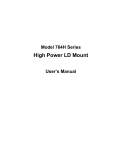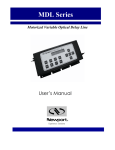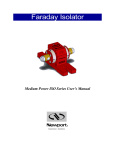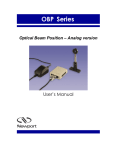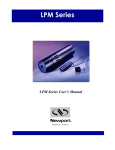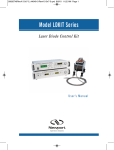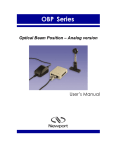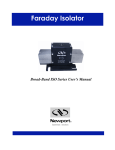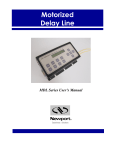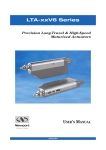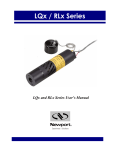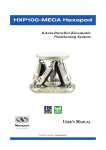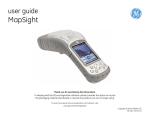Download Model 1918-C Series Optical Meters Start Up Guide
Transcript
Model 1918-C Hand-held Optical Meter Start Up Guide Start Up Guide First printing 2006 © 2006 by Newport Corporation, Irvine, CA. All rights reserved. No part of this start up guide may be reproduced or copied without the prior written approval of Newport Corporation. This start up guide has been provided for information only and product specifications are subject to change without notice. Any change will be reflected in future printings. Newport Corporation 1791 Deere Avenue Irvine, CA, 92606 USA Part No. 90000777, Rev. A 1 User’s Manual and Future Updates Dear Customer, This Start Up Guide contains essential information, including safety precautions and start up procedures, needed to get your new optical meter up and running. Please review it prior to unpacking and powering up the instrument. Other important information regarding the use and operation of the optical meter is included in the complete User’s Manual. The complete User’s Manual in Adobe PDF format, and the instrument software drivers, are included on the accompanying CD. You can also view a copy of the User’s Manual, and obtain the instrument software drivers, on the Newport web site. In an effort to keep the 1918-C Optical Meter optimized for your applications, Newport will on occasion update existing and add new features to this instrument. To utilize this new functionality will require an update to the instrument's firmware, which can be easily accomplished by the user, as described in the User’s Manual. Please check the product page on the Newport web site (www.Newport.com) for newer versions of the firmware and the User’s Manual. Call your local Newport application specialist if you need support with locating or downloading these files. Enjoy your new instrument! Start Up Guide 3 EU Declaration of Conformity We declare that the accompanying product, identified with the mark, complies with requirements of the Electromagnetic Compatibility Directive, 89/336/EEC and the Low Voltage Directive 73/23/EEC. Model Number: 1918-C Year mark affixed: 2006 Type of Equipment: Electrical equipment for measurement, control and laboratory use. Standards Applied: Compliance was demonstrated to the following standards to the extent applicable: BS EN61326-1: 1997+A1+A2 +A3 “Electrical equipment for measurement, control and laboratory use – EMC requirements” Performance criteria B was achieved during immunity tests. This equipment meets the CISPR 11 Class A Group 1 radiated and conducted emission limits. BS EN 61000-3-2:2001, Harmonic current emissions, Class A BS EN 61000-3-3:2002, Voltage fluctuations and flicker BS EN 61010-1:2001, 2nd Edition “Safety requirements for electrical equipment for measurement, control and laboratory use” Bruno Rety Group Director of PPT Instrument and Motion Europe Zone Industrielle 45340 Beaune-la-Rolande, France Dan Dunahay Director of Quality Systems 1791 Deere Avenue Irvine, Ca. USA 4 Start Up Guide 1 Safety Precautions Please carefully read the following important safety precautions prior to unpacking and operating this equipment. In addition, please refer to the complete User’s Manual for additional important notes and cautionary statements regarding the use and operation of the equipment. 1.1 Symbols and Definitions The following are definitions of symbols that are used throughout this Start Up Guide to call your attention to important information regarding your safety, the safety and preservation of your equipment or an important tip. WARNING Situation has the potential to cause bodily harm or death. CAUTION Situation has the potential to cause damage to property or equipment. ELECTRICAL SHOCK Hazard arising from dangerous voltage. Any mishandling could result in irreparable damage to the equipment, and personal injury or death. NOTE Additional important information the user or operator should consider. 1.2 General Warnings Observe these general warnings when operating or servicing this equipment: • • • • • • Heed all warnings on the unit and in the operating instructions. Do not use this equipment in or near water. Route power cords and other cables so they are not likely to be damaged. Disconnect power before cleaning the equipment. Do not use liquid or aerosol cleaners; use only a damp lint-free cloth. Lockout all electrical power sources before servicing the equipment. To avoid explosion, do not operate this equipment in an explosive atmosphere. Start Up Guide • 1.3 5 Qualified service personnel should perform safety checks after any service. General Cautions Observe these cautions when operating or servicing this equipment: • • • • • • • • • 1.4 If this equipment is used in a manner not specified in this manual, the protection provided by this equipment may be impaired. Do not position this product in such a manner that would make it difficult to disconnect the power cord. There are no user-serviceable parts inside the 1918-C Optical Meter, with the exception of the battery. Use only the Newport Model 1918-BAT battery. Use only the Newport Model 1918-PS external power supply. Follow precautions for static sensitive devices when handling this equipment. This product should only be powered as described in the manual. To prevent damage to the equipment, read the instructions in the equipment manual for proper input voltage. Adhere to good laser safety practices when using this equipment. Unpacking and Handling It is recommended that the 1918-C Optical Meter be unpacked in a lab environment or work site. Inspect the box carefully to verify all items identified in section 1.6 are included. 1.5 Inspection for Damage The 1918-C Optical Meter is carefully packaged at the factory to minimize the possibility of damage during shipping. Inspect the box for external signs of damage or mishandling. Inspect the contents for damage. If there is visible damage to the instrument or accessories upon receipt, inform the shipping company and Newport Corporation immediately. WARNING Do not attempt to operate this equipment if there is evidence of shipping damage or you suspect the unit is damaged. Damaged equipment may present additional hazards to you. Contact Newport technical support for advice before attempting to plug in and operate damaged equipment. 6 Start Up Guide 1.6 Parts List The following is a list of parts included in the hardcase with the 1918-C Optical Meter: 1. This Quick Start Guide (Hard copy) 2. CD containing the Software Drivers and Utilities and the User Manual 3. Battery 1918-BAT 4. External Power Supply 1918-PS 5. Power cord 1918-PSC If you are missing any hardware or have questions about the hardware you have received, please contact Newport Corporation. 1.7 Choosing and Preparing a Suitable Work Surface The Model 1918-C Optical Meter may be placed on any reasonably firm table or bench during operation. The kickstand can be rotated to two angles to improve visibility of the LCD display, as needed. Provide adequate distance between the Model 1918-C Optical Meter and adjacent walls for ventilation purposes. Approximately 2-inch spacing for all surfaces is adequate. 1.8 Electrical Requirements Before attempting to power up the unit for the first time, the following precautions must be followed: • If the power supply is equipped with a 3-prong plug, connect the instrument to properly earth-grounded 3-prong receptacle only. WARNING If the power supply is equipped with a 3-prong plug, connect the instrument to properly earth-grounded, 3-prong receptacles only. Failure to observe this precaution can result in severe injury. • Have a qualified electrician verify the wall socket that will be used is properly polarized and properly grounded. Start Up Guide 1.9 7 Battery and External Power Supply CAUTION The battery needs to be charged for at least 4 hours before using the optical meter without the external power supply. The 1918-C Optical Meter is shipped from the factory with the battery removed from the unit. Install the battery before plugging the external power supply and before turning on the unit. To install the battery, first remove the battery compartment cover from the back of the unit. Connect the 5-pin battery connector to the corresponding connector inside the battery compartment (Figure 1). The connector is keyed and can only be inserted in one direction so please be careful to properly align the connector pins. Carefully fold the battery wires inside the battery compartment so that the wires will not put pressure on the battery compartment cover. Close the cover and make sure it latches in place. Battery Connector Battery Figure 1 Rear panel with the battery cover removed 8 Start Up Guide CAUTION The battery needs to be removed if the instrument is going to be unused for more than 3 weeks. Failure to do so may result in over-discharging the battery which drastically reduces the battery life or may cause battery breakdown. AC power is supplied through an external power supply that provides in-line transient protection and RF filtering. This power supply is universal which means it can work at 90-264 VAC and 50/60 Hz. CAUTION Permanent damage may occur to the optical meter if an external power supply other than the Newport 1918-PS is used. Please call Newport Corporation if extra power supplies are needed for a particular setup. CAUTION Do not operate with a line voltage that is not within 90-264 VAC. Start Up Guide 2 2.1 9 System Start Up Startup Procedure Provided that the Optical Meter has been installed in an appropriate environment and its external power supply power cord is connected to a working electrical outlet, power-up the Optical Meter by pressing the power button on the upper right corner of the left side panel. The battery will start charging. If the Optical Meter is turned on for the first time, make sure the external power supply is not unplugged from the AC outlet for at least 4 hours. During charging, the Optical Meter can be used for measurements. At the end of the charging time, the Optical Meter can be used without the external power supply. For the highest precision and accuracy, the 1918-C Optical Meter should be allowed to warm up for one hour before being used for measurements. 2.2 Front Panel Layout Navigation Keys Escape Key Dedicated Keys Reconfigurable (Soft) Keys Figure 2 Front Panel keys 10 Start Up Guide 2.2.1 Front Panel Elements The front panel of the 1918-C features the following elements (Figure 2): • • • • A faceplate with a 4” active color liquid crystal display Menu/Enter and Esc keys Rubberized horizontal (left/right) and vertical (up/down) arrow keys Four rubberized blank keys below the display (referred to as “soft keys” later in the manual, as their function depends on the text on the screen above the key.) • Six rubberized buttons with dedicated functions – Range, Mode, Hold, Filter, Lambda (λ), Zero. 2.2.2 Understanding the Main Screen The main screen is displayed after startup (Figure 3). The middle portion of the main screen is a real-time display of power measured in last used units, and the lower half of the main screen is a row of four labels for actions that the keys below them will activate. When an annunciator label is visible, its function is enabled. If the annunciator appears on the display as an unlabeled key, the function it represents is currently disabled. Annunciators loosely correspond to keypad keys, which are used either alone or in combination with the navigation and selection keys to control annunciator functions. Figure 3 Front Panel Layout Start Up Guide 2.3 11 Side Panel Layout Input Connectors The input connectors are on the side panel. The 1918-C Optical Meter model supports input from external detectors through a DB15 detector connector. The external power supply is plugged in the DC INPUT connector. Output Connectors The 1918-C Optical Meter has an analog output, which enables direct monitoring of a detector through an oscilloscope or voltmeter. 2.3.1 Side Panel Layout The side panel is a brushed aluminum plate with input and output connectors, a standby switch, and LED indicators (Figure 4) • • • • • • Standby switch. This is a push-on/push-off button for turning the unit on or off. Note that the battery charger functions whenever the external supply is attached, even when the Standby switch is Off. Ground Pin. The user can connect the Optical Meter to an Earth Ground for sensitive measurements. 15-Pin D-Sub Optical Detector Input. 2.5 mm Jack Analog Output. Mini USB Connector labeled USB PC. This connector is used for sending remote commands to the Optical Meter from a PC. USB “A” connector labeled USB MEM. This connector is used for saving the data on a USB Memory and for firmware upgrades. 12 Start Up Guide Analog Out Standby Switch Mini USB Connector USB “A” Connector Charge Status Indicator 15-pin D-Sub Detector Connector Power Indicator DC Input Connector Grounding Pin Figure 4 Side Panel Layout CAUTION Permanent damage may occur to the optical meter if an external power supply other than the Newport 1918-PS is used. Please call Newport Corporation if extra power supplies are needed for a particular setup. Start Up Guide 2.4 13 Rear Panel Layout Battery compartment cover Labels Kickstand Figure 5 2.4.1 Rear panel Rear Panel Elements The rear panel of the 1918-C features the following elements (Figure 5): • Battery compartment cover • Kickstand • Labels Markings on the rear panel identify the instrument compliance with different standards and regulations. CAUTION There are no user-serviceable parts inside the Optical Meter. Work performed inside the Optical Meter by persons not authorized by Newport may void the warranty. 2.4.2 Kick Stand Positions The instrument can be used in 4 viewing angles, allowing the user to adjust for the height of the work surface and lighting conditions: o Laying on its back side in the horizontal position o Standing up on its bottom side in the vertical position o At two angled positions, by moving the kick-stand into two, preconfigured notches, manufactured into the instrument body (Figure 6). 14 Start Up Guide Figure 6 2.5 Kickstand in the first angled position Firmware Upgrade Procedure Firmware Upgrade is an easy, straight-forward process. Simply copy firmware files (PM1918APP.EXE and XMLFILE1.XML) to a WinCE compatible USB Flash Drive and then plug it into the USB connector on the front of the instrument. Then wait a few seconds for the instrument to recognize the USB Flash Drive. The Optical Meter will detect the new firmware files and will ask if you want to download the files. Press the “Yes” softkey to start the upgrade process. The Optical Meter will instruct you to restart once the upgrade is successful. Restart the Optical Meter by turning it OFF and back ON. The Optical Meter will restart running the new firmware. New firmware files may be available either through the Newport web site (http://www.newport.com) at the product page or through your local Newport application specialist. 2.6 PC Operation of Instrument NOTE Before plugging the instrument into a PC via a USB communication port, please make sure that the USB Drivers are installed. Run Setup.exe from the Software CD that came with your product. The installation program will configure the PC with the Optical Meter Series USB drivers. Start Up Guide 3 3.1 15 Maintenance, Service and Support Enclosure Cleaning WARNING Before cleaning the enclosure of the 1918-C Optical Meter, the AC power cord must be disconnected from the wall socket. The enclosure should only be cleaned with isopropyl alcohol or a mild soapy water solution applied to a damp lint-free cloth. 3.2 Service and Technical Support CAUTION DO NOT OPEN COVER. There are no user serviceable parts inside the 1918-C Optical Meter. Work performed by persons not authorized by Newport Corporation will void the warranty. Calibration accuracy is warranted for a period of 1 year. After 1 year, the unit should be returned to Newport Corporation for recalibration and NIST trace ability re-certification. To obtain information regarding factory service, contact Newport Corporation’s Service Department or your Newport representative. Please have the following information available: • • • • Instrument model number (on the rear panel) Instrument serial number (on rear panel) Description of the problem Your contact information To help our Technical Support Representatives diagnose your problem, please note the following conditions: • • • • Is the system used for manufacturing or research and development? What was the state of the system right before the problem? Have you seen this problem before? If so, how often? Can the system continue to operate with this problem? Or is the system non-operational? 16 Start Up Guide • Can you identify anything that was different before this problem occurred? Technical Support Contact Information North America & Asia Newport Corporation Service Dept. 1791 Deere Ave. Irvine, CA 92606 Telephone: (949) 253-1694 Telephone: (800) 222-6440 x31694 Europe Newport/Micro-Controle S.A. Zone Industrielle 45340 Beaune la Rolande, FRANCE Telephone: (33) 02 38 40 51 56 Asia Newport Opto-Electronics Technologies 253 Aidu Road, Bld #3, Flr 3, Sec C, Shanghai 200131, China Telephone: +86-21-5046 2300 Fax: +86-21-5046 2323 Return Procedure If there are any defects in material or workmanship or a failure to meet specifications, promptly notify Newport's Returns Department within the warranty period by calling 1-800-222-6440 or by visiting our website at www.newport.com/returns to obtain a Return Material Authorization Number (RMA#). Return the product to Newport Corporation, freight prepaid, clearly marked with the RMA# and we will either repair or replace it at our discretion. Newport is not responsible for damage occurring in transit and is not obligated to accept products returned without an RMA#. E-mail: [email protected] Newport Corporation Worldwide Headquarters 1791 Deere Avenue Irvine, CA 92606 (In U.S.): 800-222-6440 Tel: 949-863-3144 Fax: 949-253-1680 Internet: [email protected] Visit Newport Online at: www.newport.com


















